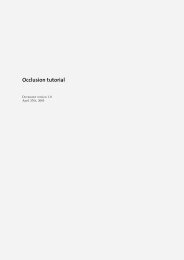mental ray Architectural and Design Visualization Shader Library
mental ray Architectural and Design Visualization Shader Library
mental ray Architectural and Design Visualization Shader Library
You also want an ePaper? Increase the reach of your titles
YUMPU automatically turns print PDFs into web optimized ePapers that Google loves.
2.3 Features 11In the real world “highlights” are just (glossy) reflections of the light sources. In computergraphics it’s more efficient to treat these separately. However, to maintain physical accuracythe material automatically keeps “highlight” intensity, glossiness, anisotropy etc. in sync withthe intensity, glossiness <strong>and</strong> anisotropy of reflections, hence there are no separate controls forthese as both are driven by the reflectivity settings.2.3.5 Transparency FeaturesThe material supports full glossy anisotropic transparency, as well as includes a translucentcomponent, described more in detail on page 25.Translucency2.3.5.1 Solid vs. Thin-WalledThe transparency/translucency can treat objects either as solid or thin walled.If all objects were treated as solids at all times, every single window pane in an architecturalmodel would have to be modeled as two faces; an entry surface (that refracts the light slightlyin one direction), <strong>and</strong> immediately following it an exit surface (where the light would berefracted back into the original direction).Not only is this additional modeling work, it is a waste of rendering power to model a refractionthat has very little net effect on the image. Hence the material allows modeling the entirewindow pane as one single flat plane, foregoing any actual “‘refraction” of light.
















